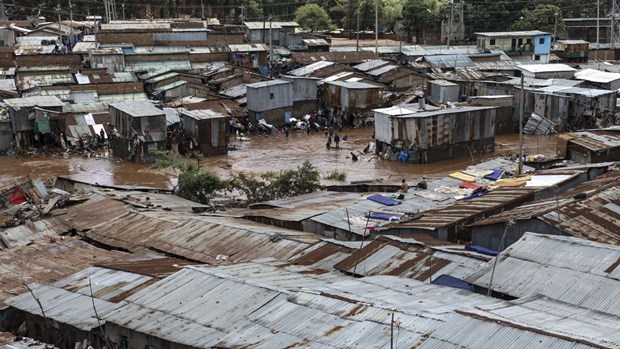 Opinion
Opinion

UNDP Resident Representative a.i. in Việt Nam, Terence D. Jones talks with Việt Nam News about the impacts of the COVID-19 pandemic on poverty reduction efforts on the International Day for Eradication of Poverty and National Day for the Poor (October 17)

|
| No Title |
UNDP Resident Representative a.i. in Việt Nam, Terence D. Jones talks with Việt Nam News about the impacts of the COVID-19 pandemic on poverty reduction efforts on the International Day for Eradication of Poverty and National Day for the Poor (October 17)
How has the pandemic affected the poverty reduction achievements in the world and in Việt Nam?
A new analysis on global poverty released last week finds that 1.3 billion people are multidimensionally poor. The global Multidimensional Poverty Index (MPI) produced by the United Nations Development Programme (UNDP) and the Oxford Poverty and Human Development Initiative measures poverty by considering various deprivations experienced by people in their daily lives, including poor health, insufficient education, and a low standard of living.
While complete data on the impacts of COVID-19 on the MPI are not yet available, the pandemic has exposed cracks in social protection systems, access to education, healthcare services, and workers’ vulnerability around the world.
UNDP Administrator Achim Steiner said, and I quote: “The COVID-19 pandemic has eroded development progress around the world, and we are still grappling to understand its full impacts. This year's Multidimensional Poverty Index (MPI) reminds us of the need for a complete picture of how people are being affected by poverty, who they are and where they live, if we are to build forward better from this crisis and design effective responses that leave no one behind.”
In Việt Nam, UNDP’s study in collaboration with the Center for Analysis and Forecasting under the Vietnam Academy of Social Science shows that 63.5 per cent of all households experienced an income drop of 30 per cent or more from the pre-pandemic period (December 2019). The rate of transient income poverty had surged from under 10 per cent pre-crisis to 33.4 per cent in July 2021 (based on the 2021-2025 poverty line issued by the Ministry of Labour, Invalids and Social Affairs). Nine out of ten vulnerable households suffered from employment impacts in July 2021, and nearly two thirds of households experienced an income drop of 30 per cent or more from the pre-pandemic period.
Food security is becoming an issue with 51.2 per cent of the households having to reduce the amount of food served per meal, and 17.7 per cent of households reducing the number of meals per day. This is worrying because there is a very large number of people involved, both in rural and in urban areas and we feel that the way to address this transient poverty quickly is to increase the size of the cash assistance programmes.
The Vietnamese Government implemented a second package to support those affected by the pandemic, including vulnerable and poor people. What are your thoughts on this?
Our latest study with the Institute of Labour Science and Social Affairs, under the Ministry of Labour, Invalids and Social Affairs, shows that nine out of ten vulnerable households had not yet received assistance, either because they are migrants, they don't have local registration, or because they are in the informal sector or household businesses that are not on the tax rolls, and so for the administrative procedures that they have to go through in order to get assistance, it is quite complex and often they fail to receive assistance.
The report makes important recommendations to address these areas for improvement. And thus the Government has just made some adjustment in the second package design (under the Government Resolution No. 126) that has resulted in further widening the coverage to elderly people and people with disability; increasing the central budget allocation for localities up to 70 per cent and simplifying the administrative procedures to access policies on zero interest loans for paying salary and production recovery.
However, with the third support package being rolled out, we think the cash assistance programme needs to be expanded, particularly in the last quarter of this year. The coverage needs to be widened to all impacted people, especially all vulnerable groups. It is important to ensure that the flow of funding is rapid and that the administrative procedures are minimal to get the assistance out as quickly as possible to those who need it the most, for example through provincial emergency budgets.
What would the UNDP recommend for Việt Nam to protect the vulnerable from this socio-economic shock?
The impact of the fourth wave of the pandemic in Việt Nam is immense. Vulnerable people are reducing their spending quite dramatically because of the pandemic, even reducing food and milk for children. To urgently address the problem, we recommended a new cash assistance programme of approximately five per cent of quarterly GDP (of approximately VNĐ77 trillion), to be financed by the central government and disbursed over the final months of 2021.
The objective of this is to aid disadvantaged people in case of a longer lockdown, and to sustain domestic consumption. The emphasis is on goods and services that are most needed that are domestically produced, which would stimulate domestic production, create jobs, and increase Government revenue.
The quickest way to deliver this support is to provide an immediate cash transfer to vulnerable groups, including all children under six years old (about 11 million), pregnant women, elderly people from 60 years (about 11.5 million), people with disabilities and any other group that commune-level governments define as having fallen into deprivation.
There should be minimal administrative requirements, including application of a digital system for self-registration of eligible individuals and local government verification (building on the good experience from southern Đồng Nai Province), and digital tools in delivering the cash assistance to beneficiaries. The cash assistance can be made monthly or one-time payment, for a period of at least three final months of 2021 and the amount can be linked to minimum subsistence requirements according to Decree 20/2021/NĐ-CP (replacing Decree 136/2013/NĐ-CP).
To effectively help migrant workers to stay where they are and protect them from deprivation, the central government needs to issue an immediate ban on evictions in affected areas. The government could have a rent replacement programme to pay landlords for a short period, one month or two months, to enable those people who are migrants to be able to stay in their rented accommodations where they are now.
What should Việt Nam do in the medium term to ensure social assistance and economic growth?
In medium term, it is important to accelerate the reform of social assistance policies and programmes to make them more inclusive and shock-responsive, while making the best use of digital technologies to combat the pandemic:









